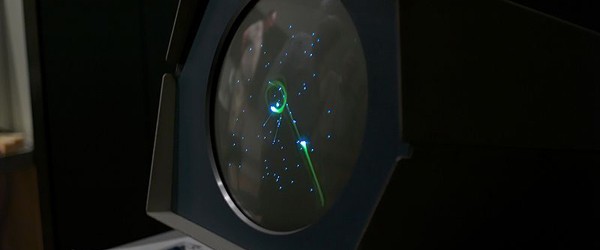This post has not been edited by the GamesBeat staff. Opinions by GamesBeat community writers do not necessarily reflect those of the staff.

“THIS IS GALACTIC DANCING.” So reads the text prompt preceding the bonus stages in Galaga ’91, one of the games on display at The Museum of the Moving Image’s current video game exhibition, “Spacewar! Video Games Blast Off.”
Using the world’s first video game, Spacewar! (running on a facsimile PDP-1 simulation), the exhibition follows the development of space shooting video games from those primitive vector displays with their simple geometric representations of science-fiction fantasies through some growing pains like a Virtual Boy running Vertical Force (1995) and into contemporary games like Child of Eden (2011) and Portal (2007).
So, what exactly is Portal doing in among all these space shoot-em-ups? That’s what I was thinking as I stood on the museum’s third floor watching a child play Valve’s puzzle-shooter as I leaned up against a Star Wars cabinet from 1983.
With video games on display in a museum setting, a set of circumstances develops and a certain atmosphere exists that helps to withhold any questions as to a digital game’s value as an art form. Instead, the mind is freed to examine which elements of artistry are being demonstrated when we observe or play games. It’s a question we don’t often think about when we are sitting at home passively entertaining ourselves. Still, when we do ask ourselves this question, it is my experience that we value games on their representational value. As in: What does this game mean? What is it trying to say? And how do the graphical and narrative themes help communicate all this?
Looking for representational value in Asteroids (1979), what can we find? Without taking our own artistic liberties with the stark white rudimentary geometry of the game, we are given the harrowing story of a spaceship that shoots asteroids. We could dig in to the historical context and maybe describe how the popularity of space warfare games between the ’60s and ’80s had a lot to do with cold war anxieties and the space race. Either way, that does not explain why Portal and Super Mario Galaxy 2 are on display in a museum hall alongside Yar’s Revenge and Star Fox.

What the Museum of the Moving Image has really put together here is a logic of artistic continuity that takes into account not only the representational aspects of space shoot-em-ups but also lends a cleverly trained eye towards game mechanics and user interfaces. Simply, games allow for the creation of alternate physical realities to play in.
From Space Wars’ (1977) sun-dragging lasers and asteroids toward the middle of the battlefield, we can see the laws of gravitation affecting the action of a simple shootout, which leads us to where in Super Mario Galaxy Nintendo used the laws of gravitation toward pint-sized planets as a creative way of making new avenues of locomotion and puzzles for the platforming Italian plumber. And into Portal, which places the player into a fictionalized physics experiment.
Being a commercial medium, seeing games in a museum allows for an evaluation of a gaming experience that is free from the effect of consumer satisfaction. Seeing a Virtual Boy in a museum and being able to play it — without the dissatisfaction at a piece of $170 hardware that by everyone’s estimation failed to launch — allows for an actual appreciation of the sense of immersion that manufacturer Nintendo attempted. It also helps in developing a further understanding of why, from a practical standpoint, the Virtual Boy was an absolute flop. Yet from the perspective of a short play test, Vertical Force reveals itself to be an adequately fun and immersive experience.
Seeing the deliberate selection of a wide swath of various modes of implementation and design philosophies across the entire history of gaming allows for the opening of a more all encompassing view of how we can appreciate the artistry of a gaming experience. From simple geometry to detailed representations and idiosyncratic mechanisms (the hulking Galaxy Force machine is a must see), artistry in games can come from the most abstract to the most distinct and even be concerned primarily with spaceships for some thirty years.
Seeing games on display (and, more importantly, open for playing) at a museum is proof positive that games have cemented themselves in the art world. Beyond that, the atmosphere offered by a museum context opens up the door to a multifaceted discussion of the many unexamined elements of artistry in games — to help us understand that piloting a ship is not always piloting, sometimes you are dancing.
“Spacewar! Video Games Blast Off” is on display at the Museum of the Moving Image in Astoria Queens until March 3, 2013.
Full game list (subject to change):
Spacewar! (1961–62), PDP-1 model
Computer Space (1971), arcade
Space Wars (1977), arcade
Space Invaders(1978), arcade
Asteroids (1979), arcade
Battlezone (1980), arcade
Defender (1980), arcade
Missile Command (1980), arcade
Tempest (1981), arcade
Planet Zeon (1982), Tomytronic
Yars’ Revenge (1982), Atari Video Computer System
Star Wars (1983), arcade
Metroid II: Return of Samus (1991), Game Boy
Galaxy Force II (1988), arcade
Galaga ‘91 (1991), Game Gear
Star Fox (1993), Super Nintendo Entertainment System
Vertical Force (1995), Virtual Boy
Portal (2007), PS3
Osmos (2009), iPad
Super Mario Galaxy 2 (2010), Wii
Child of Eden (2011), Xbox 360
Curated by John Sharp
